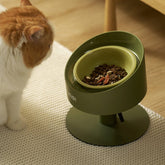How to trim your cat's nails at home
 Cat nail trims can sometimes feel like a wrestling match between you and your furry friends. On the one hand, you want your cat's nails to look well-groomed and in good condition, while your cats don't seem to see eye to eye with this notion. Don't get me wrong, some cats don't mind getting their claws trimmed, but for others, let's just say they like to keep their nails for other things, like teaching you why you should never cut them in the first place. But don't worry, we are here to help you out and at least make the process much easier for both you and your furry friends.
Cat nail trims can sometimes feel like a wrestling match between you and your furry friends. On the one hand, you want your cat's nails to look well-groomed and in good condition, while your cats don't seem to see eye to eye with this notion. Don't get me wrong, some cats don't mind getting their claws trimmed, but for others, let's just say they like to keep their nails for other things, like teaching you why you should never cut them in the first place. But don't worry, we are here to help you out and at least make the process much easier for both you and your furry friends.
When should you trim your cat's nails?
As a rule of thumb, give your cat nail trims every 1.5 - 2 weeks to avoid their claws from getting too long. Overgrown claws may bring retracting problems and cause them to get stuck all over the place, like that brand-new carpet you just bought or your costly leather sofa. We wouldn't want that happening right? Yeah, I wouldn't either. So how can you make the nail trimming process more enjoyable for you and your furry friends? Let's find out.
Get your cat accustomed to nail trims
First and foremost, progressively get your cat to become more used to nail trims. In this way, your furry friends will come to know that the experience is not all gloomy and when the time to glam up their claws comes, you will be met with less resistance and fewer battle scars to remember. So regardless of age, begin making active steps in getting your cat accustomed to getting their paws handled, as well as the sound and look of nail clippers. Make sure that these early experiences are as positive as possible. Ideally, the best time to start trimming your cat's nails is when they are still just little kittens. Getting them used to it early will make things much easier over time

Build the right setting
Before getting started, make sure that both you and your cat are in an A+ mood. We wouldn't want to see you...or your cat starting a wild tantrum during the process. Once you've checked that everyone's happy, it's time to get your tools ready, AKA nail clippers. The nail clippers you use can have a massive impact on the nail trim experience for your cats, so be sure you have the right ones. Some cat trimmers can cause discomfort and slight pain for your cats, which could be the reason they hate nail trims so much. I mean, not even a hard-earned treat after can make up for that.
A high-quality pair of nail clippers should be easy to use, comfortable to hold, and gentle on your nails, providing a precise and clean cut. If you have difficulty identifying the bloodlines or the quick, consider nail clippers equipped with a built-in LED light or a stopper. These features can help you determine exactly where you need to trim.

Understand your cat's claws
Before you begin with the trimming, you'll need to know all the ins and outs of cats' claws so you don't make a mess of things. One of the most important things to know is that cats have a vein called the quick run, which runs down the center of each nail. You never want to cut further than this area because it may cause pain and bleeding for your furry friends. So how do you spot it? Luckily, most cats' nails are fairly clear, so you should have no problem spotting the quick. You'll see a pink part at the center of the nail, which is where you should never venture. When cutting your cat's nails, try and leave a buffer space between the point you wish to clip and the quick in case your furry friends move or an accident happens.
Now on to the nail clipping
To trim your cat's nails, you'll want to be doing the following steps:
-
Have your clippers held in one hand, preferably your dominant hand.
-
Use your other hand to handle your cat's paws. Unlike dogs, cats' paws are retractable, and so you'll need to gently squeeze the top and bottom of each paw to extend their claws from their retracted position. (If your furry friends refuse and pull their paws away to this, stay calm and gently pet them, give them a treat, or share some affirmative words until they become more relaxed for you to give it a second try).
-
If step two worked, you'll want to isolate each nail one at a time for a perfect cut. For our long-haired furry friends, you'll have to move their fur out the way. (It could be a good idea to get a helping hand during the nail trimming process.)
-
Find the quick vein and position your nail clippers in a place that won't clip through it. As mentioned, you'll want to leave a buffer space between the quick and where you will trim.
-
Once you've got the right spot, gently but swiftly close the clipper handles to clip off the sharp end of the nail. Then, repeat steps 2, 3, and 4 for the other nails.

End the session on a good note
You've done it! You've climbed the mountain and lived to tell the tail. You've walked out of the trenches without any battle scars to show. Okay, maybe I'm acting a little extra. But after getting this far, the job is not done just yet. What you want to do is leave a lasting impression on your cat. So to keep sparking positive associations of nail trims for your cats, always try to give your cats some positive affirmations and treats after. Some experts even recommend doing this throughout the whole experience to help relax your cat and offer some distraction. Positive associations will make nail trims in the future a walk in the park.























